Remote Monitoring and Evaluation of Damage at a Decommissioned Nuclear Facility Using Acoustic Emission
Abstract
1. Introduction
2. AE Monitoring at the 105-C Reactor Facility
2.1. Acoustic Emission Sensing Systems
2.2. Installation of Acoustic Emission Systems
2.2.1. Crane Maintenance Area
2.2.2. Top Floor Level
2.3. Results and Discussion
2.3.1. Remote Monitoring at the Crane Maintenance Area
2.3.2. Evaluation of Data at the Crane Maintenance Area
2.3.3. Damage Classification Using Acoustic Emission
2.3.4. Remote Monitoring at +48 Level
3. Accelerated Corrosion Testing of the Reactor Concrete Block
3.1. Experimental Program
3.2. Results and Discussion
3.2.1. Electrochemical Measurements
3.2.2. Detection of Damage Using Acoustic Emission
4. Summary and Conclusions
Author Contributions
Acknowledgments
Conflicts of Interest
References
- Clifton, J.F. Predicting the Remaining Service Life of Concrete; National Institute of Standards and Technology: Gaithersburg, MD, USA, 1991. [Google Scholar]
- Mangual, J.; ElBatanouny, M.; Ziehl, P.; Matta, F. Acoustic-emission-based characterization of corrosion damage in cracked concrete with prestressing strand. ACI Mater. J. 2013, 110, 89–98. [Google Scholar]
- Mangual, J.; ElBatanouny, M.; Ziehl, P.; Matta, F. Corrosion damage quantification of prestressing strands using acoustic emission. J. Mater. Civ. Eng. 2013, 25, 1326–1334. [Google Scholar] [CrossRef]
- ElBatanouny, M.; Mangual, J.; Ziehl, P.; Matta, F. Early corrosion detection in prestressed concrete girders using acoustic emission. J. Mater. Civ. Eng. 2014, 26, 504–511. [Google Scholar] [CrossRef]
- Abdelrahman, M.; ElBatanouny, M.; Serrato, M.; Dixon, K.; Larosche, C.; Ziehl, P. Classification of alkali-silica reaction and corrosion distress using acoustic emission. AIP Conf. Proc. 2016, 1706, 140001. [Google Scholar]
- Fournier, B.; Berube, M.A.; Folliard, K.J.; Thomas, M. Report on the Diagnosis, Prognosis, and Mitigation of Alkali-Silica Reaction (ASR) in Transportation Structures; Transport Research International Documentation (TRID); Available online: https://trid.trb.org/view/1099043 (accessed on 30 June 2014).
- Abdelrahman, M.; ElBatanouny, M.; Ziehl, P.; Fasl, J.; Larosche, C.; Fraczek, J. Classification of alkali-silica reaction damage using acoustic emission: A proof-of-concept study. Constr. Build. Mater. 2015, 95, 406–413. [Google Scholar] [CrossRef]
- Braverman, J.I.; Xu, J.; Ellingwood, B.R.; Costantino, C.J.; Morante, R.J.; Hofmayer, C.H. Evaluation of the Seismic Design Criteria in ASCE/SEI Standard 43-05 for Application to Nuclear Power Plants; U.S. Nuclear Regulatory Commission: Washington, DC, USA, 2007; pp. 1–73. [Google Scholar]
- Kojima, F. Structural Health Monitoring of Nuclear Power Plants using Inverse Analysis in Measurements; Kobe University: Hyogo, Japan, 2009; Available online: http://www.research.kobe-u.ac.jp/csi-applmath/proc/workshopKobe/final/Section10.pdf (accessed on 31 December 2011).
- Abdelrahman, M.; ElBatanouny, M.; Ziehl, P. Acoustic emission based damage assessment method for prestressed concrete structures. Eng. Struct. 2014, 60, 258–264. [Google Scholar] [CrossRef]
- Ono, K. Application of Acoustic Emission for Structure Diagnosis; BazTech; Available online: http://yadda.icm.edu.pl/baztech/element/bwmeta1.element.baztech-article-BAR0-0060-0020 (accessed on 31 December 2011).
- Golaski, L.; Gebski, P.; Ono, K. Diagnostics of concrete bridges by acoustic emission. J. Acoust. Emiss. 2002, 20, 83–98. [Google Scholar]
- ASTM E1316-16a. Standard Terminology for Nondestructive Examinations; ASTM International: West Conshohocken, PA, USA, 2016; pp. 1–38. [Google Scholar]
- Pollock, A.A. Classical Wave Theory in Practical AE Testing. In Proceedings of the 8th International AE Symposium, Tokyo, Japan, 21–24 October 1986; pp. 708–721. [Google Scholar]
- Weng, M.S.; Dunn, S.E.; Hartt, W.H.; Brown, R.P. Application of Acoustic Emission to Detection of Reinforcing Steel Corrosion in Concrete. Corrosion 1982, 38, 9–14. [Google Scholar] [CrossRef]
- Dunn, S.E.; Young, J.D.; Hartt, W.H.; Brown, R.P. Acoustic emission characterization of corrosion induced damage in reinforced concrete. Corrosion 1984, 40, 339–343. [Google Scholar] [CrossRef]
- Zdunek, A.D.; Prine, D.W.; Li, Z.; Landis, E.; Shah, S. Early Detection of Steel Rebar Corrosion by Acoustic Emission Monitoring; NACE International: Houston, TX, USA, 1995. [Google Scholar]
- Li, Z.; Zudnek, A.; Landis, E.; Shah, S. Application of acoustic emission technique to detection of reinforcing steel corrosion in concrete. ACI Mater. J. 1998, 95, 68–76. [Google Scholar]
- Assouli, B.; Simescu, F.; Debicki, G.; Idrissi, H. Detection and identification of concrete cracking during corrosion of reinforced concrete by acoustic emission coupled to the electrochemical techniques. NDT E Int. 2005, 38, 682–689. [Google Scholar] [CrossRef]
- Ohtsu, M.; Tomoda, Y. Phenomenological model of corrosion on process in reinforced concrete identified by acoustic emission. ACI Mater. J. 2008, 105, 194–199. [Google Scholar]
- Di Benedetti, M.; Loreto, G.; Matta, F.; Nanni, A. Acoustic emission monitoring of reinforced concrete under accelerated corrosion. J. Mater. Civ. Eng. 2013, 25, 1022–1029. [Google Scholar] [CrossRef]
- Vélez, W.; Matta, F.; Ziehl, P. Acoustic emission monitoring of early corrosion in prestressed concrete piles. Struct. Control Health Monit. 2015, 22, 873–887. [Google Scholar] [CrossRef]
- Appalla, A.; ElBatanouny, M.; Velez, W.; Ziehl, P. Assessing corrosion damage in post-tensioned concrete structures using acoustic Emission. J. Mater. Civ. Eng. 2015, 28, 04015128. [Google Scholar] [CrossRef]
- ASTM E2075/E2075M-15. Standard Practice for Verifying the Consistency of AE-Sensor Response Using an Acrylic Rod; ASTM International: West Conshohocken, PA, USA, 2015; pp. 1–5. [Google Scholar]
- ASTM E2374-15. Standard Guide for Acoustic Emission System Performance Verification; ASTM International: West Conshohocken, PA, USA, 2015; pp. 1–5. [Google Scholar]
- Fowler, T.; Blessing, J.; Conlisk, P.; Swanson, T.L. The MONPAC system. J. Acoust. Emiss. 1989, 8, 1–8. [Google Scholar]
- Nair, A.; Cai, C.S. Acoustic emission monitoring of bridges: Review and case studies. Eng. Struct. 2010, 32, 1704–1714. [Google Scholar] [CrossRef]
- ElBatanouny, M.; Ziehl, P.; Larosche, A.; Mangual, J.; Matta, F.; Nanni, A. Acoustic emission monitoring for assessment of prestressed concrete beams. Constr. Build. Mater. 2014, 58, 46–53. [Google Scholar] [CrossRef]
- Nilsson, L.O.; Sandberg, P.; Poulsen, E.; Tang, L.; Andersen, A.; Frederiksen, J.M. HETEK, a System for Estimation of Chloride Ingress into Concrete Theoretical Background; Danish Technological Institute: Taastrup, Danmark, 2011. [Google Scholar]
- Vélez, W.; ElBatanouny, M.; Matta, F.; Ziehl, P.H. Assessment of Corrosion in Prestressed Concrete Piles in Marine Environment with Acoustic Emission; NACE International: Salt Lake City, UT, USA, 2012. [Google Scholar]
- ASTM C876-09. Standard Test Method for Half-Cell Potentials of Uncoated Reinforcing Steel in Concrete; ASTM International: West Conshohocken, PA, USA, 2009; pp. 1–8. [Google Scholar]
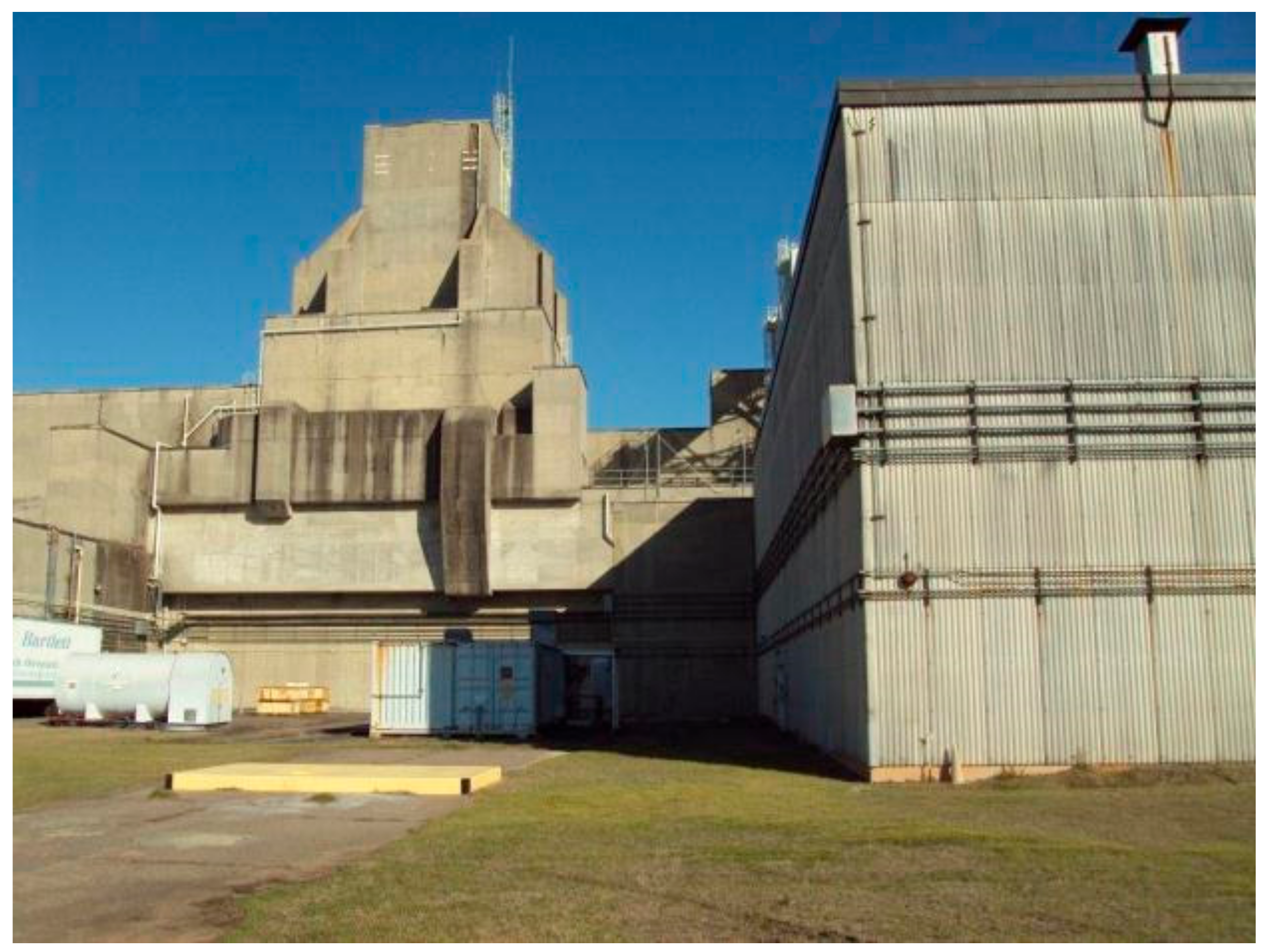
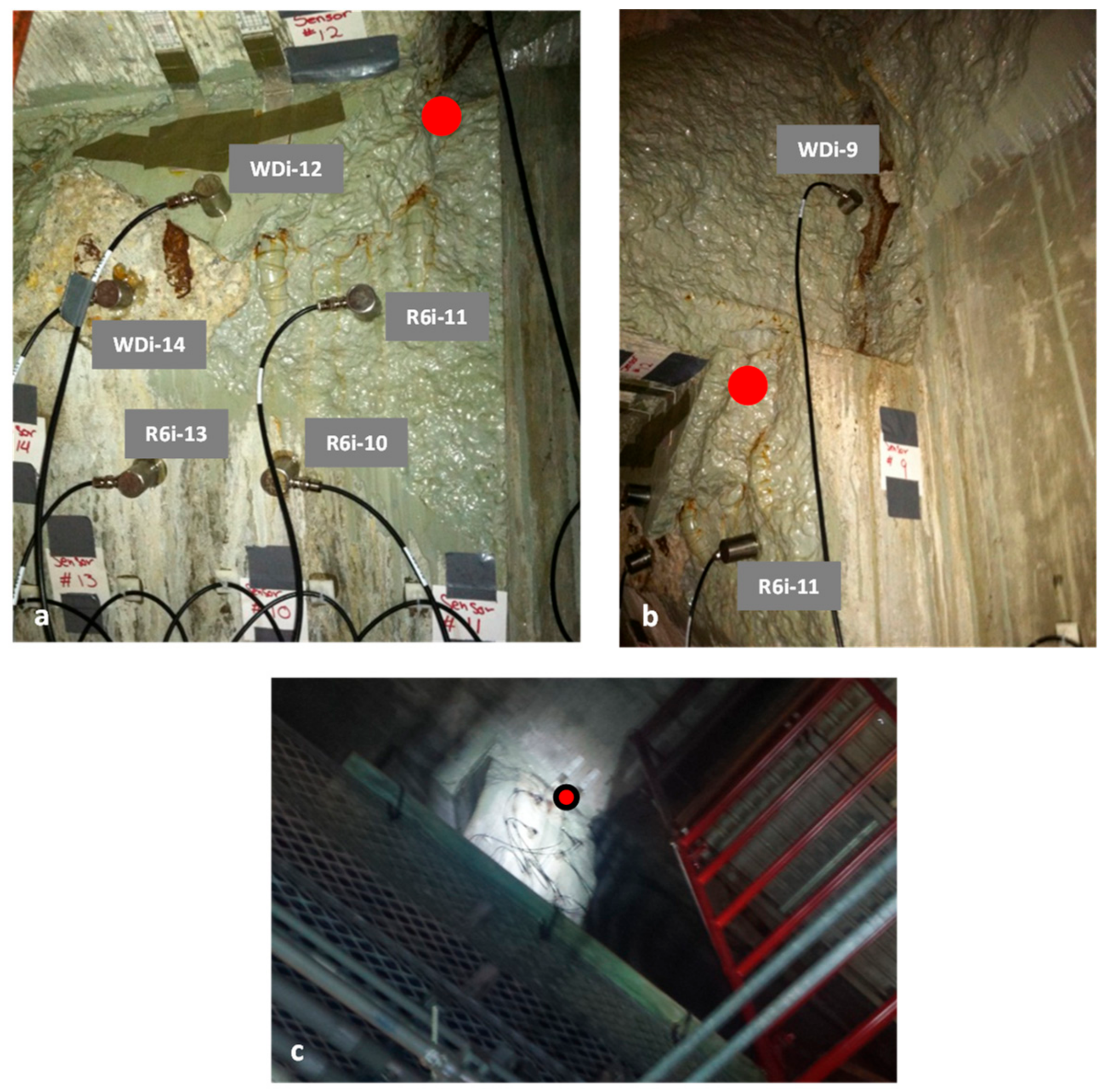
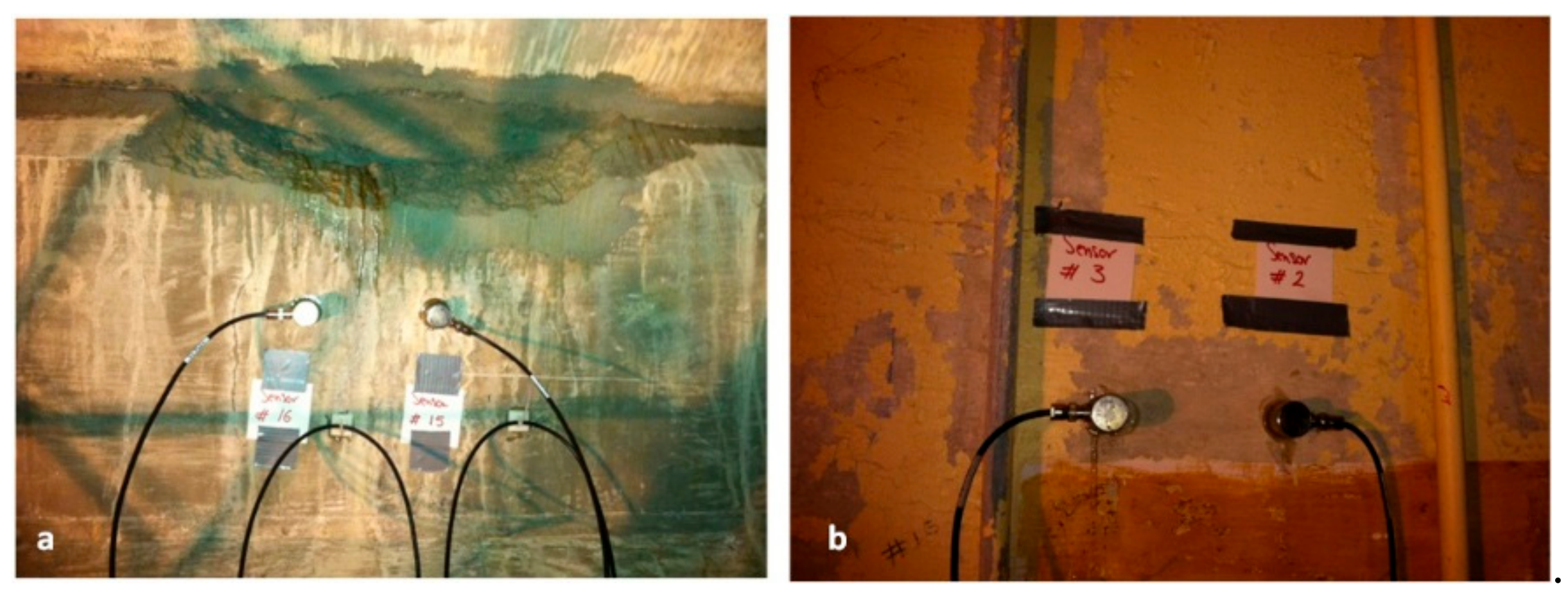
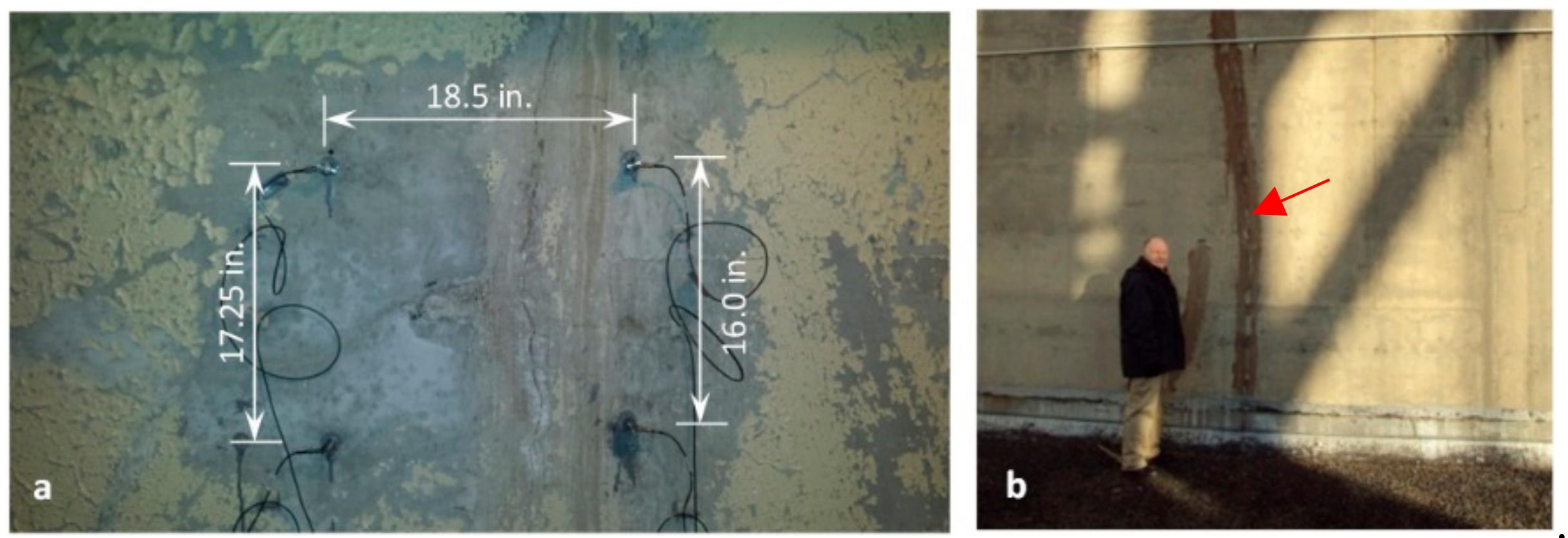
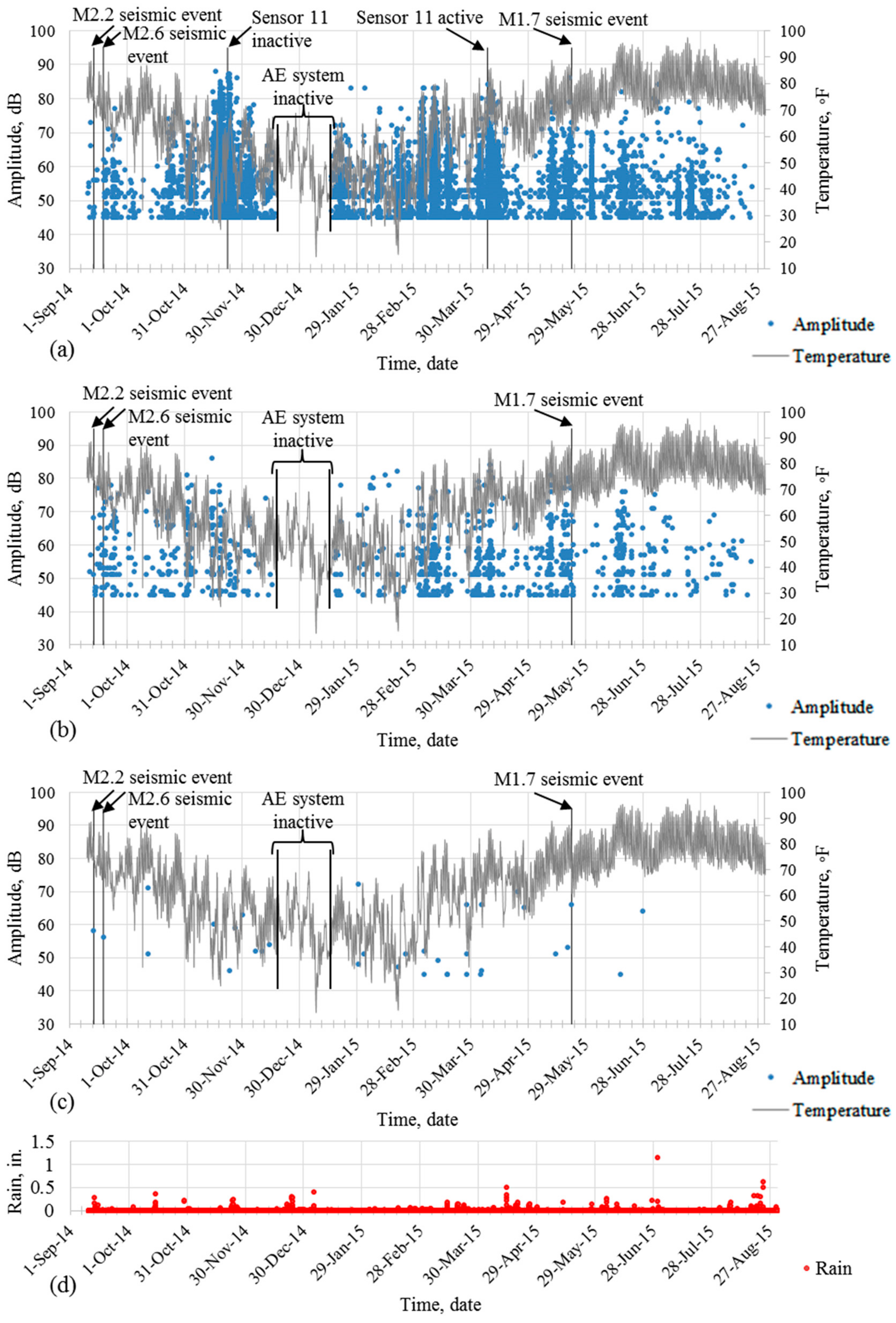
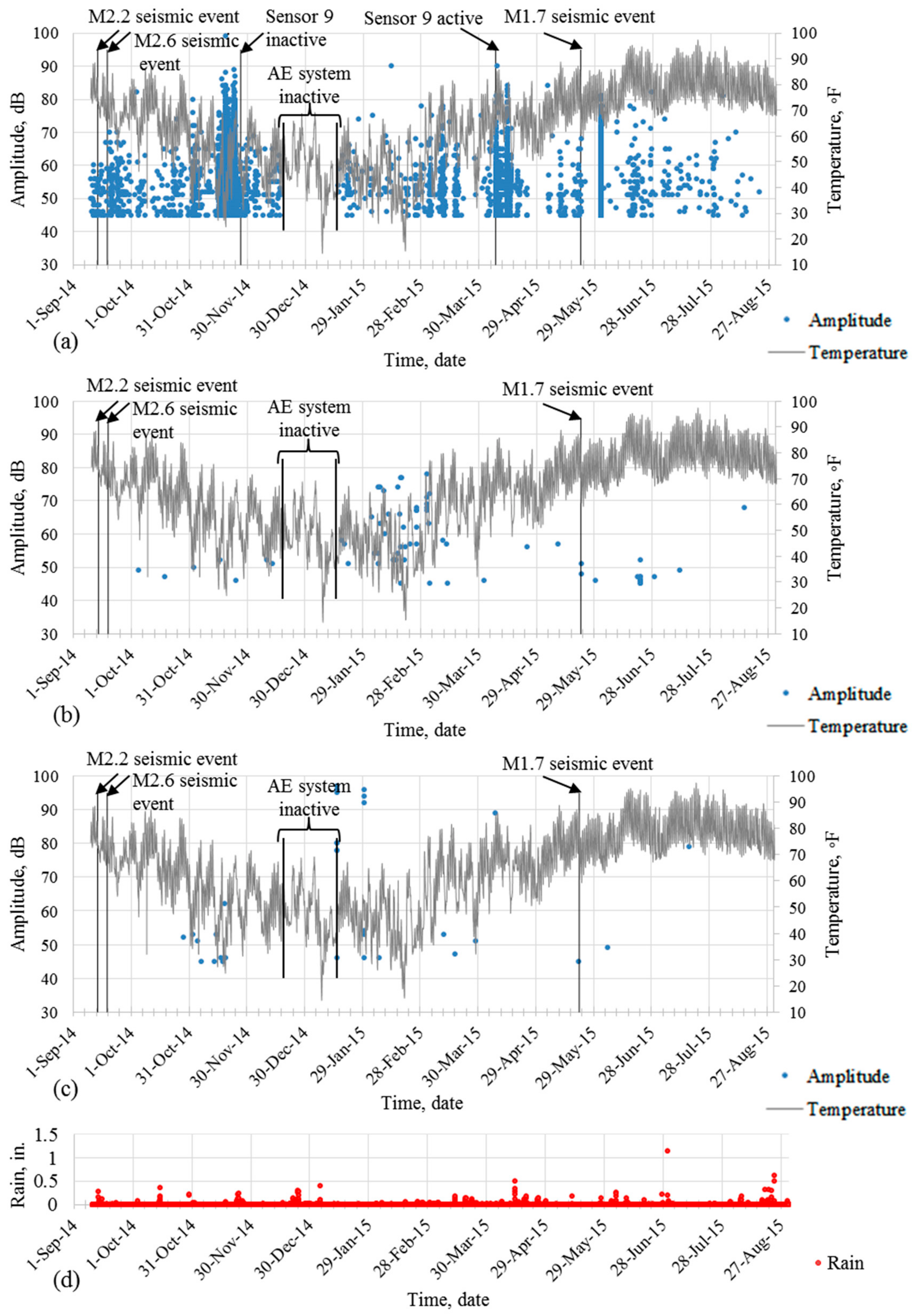
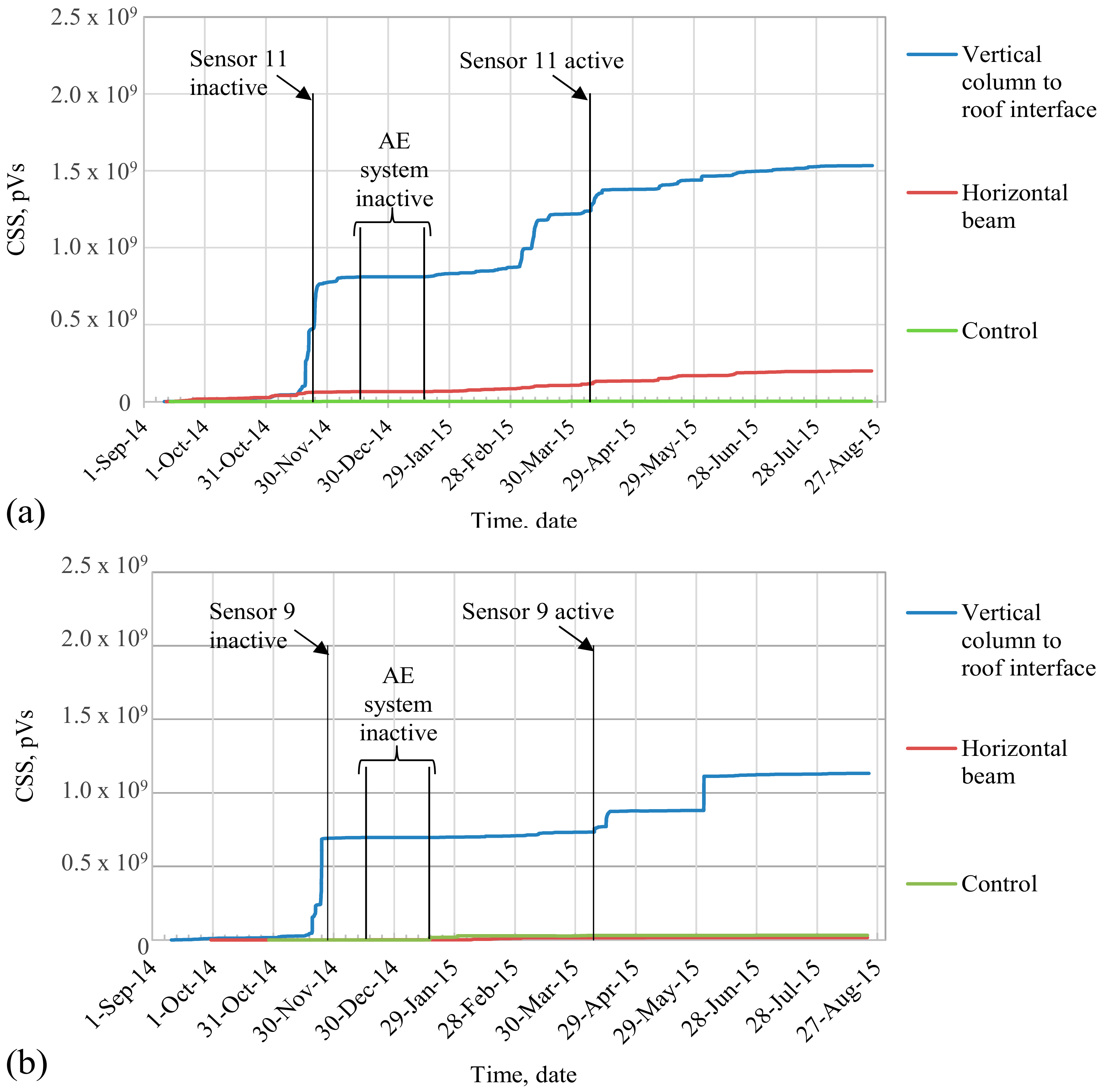
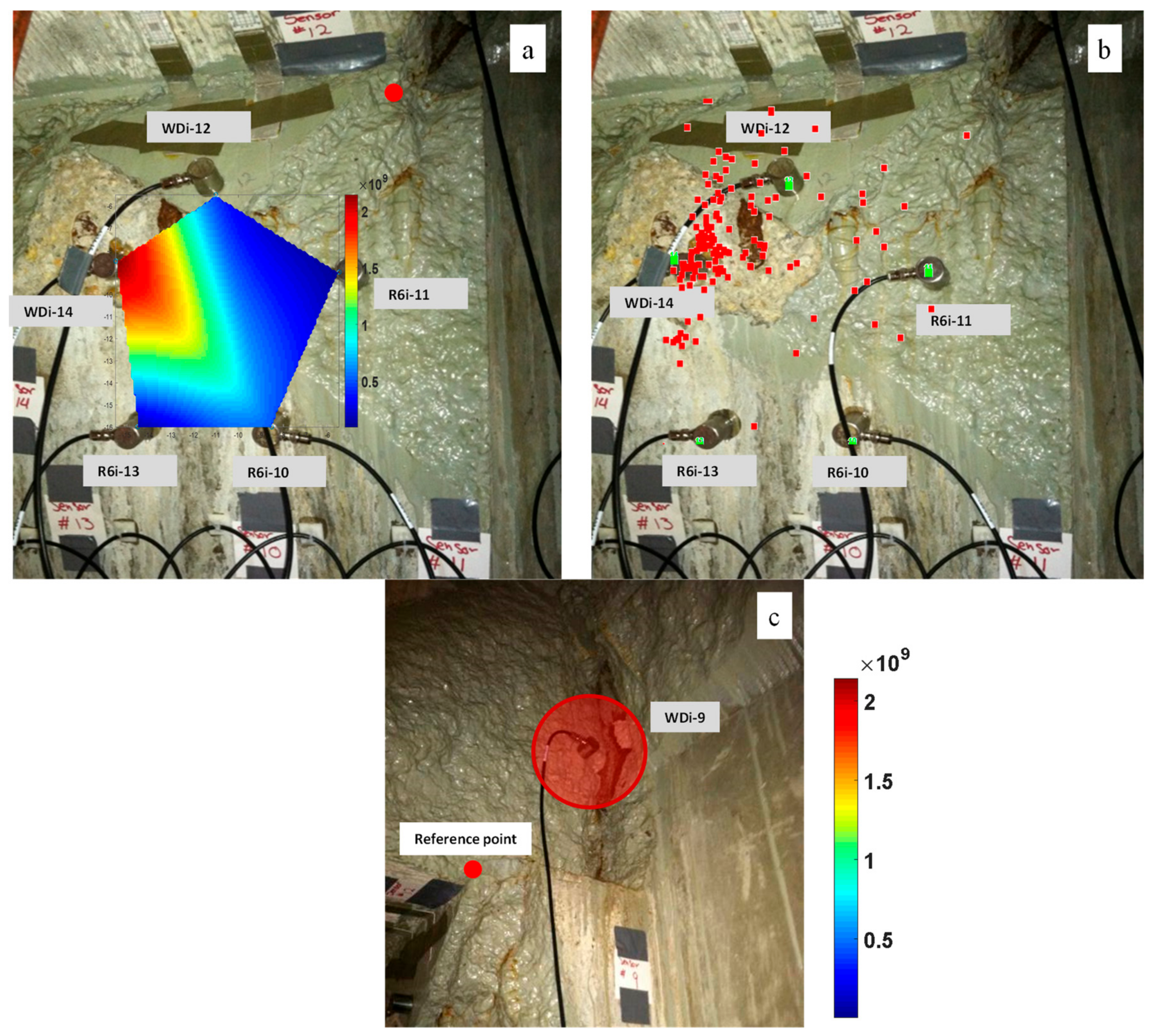
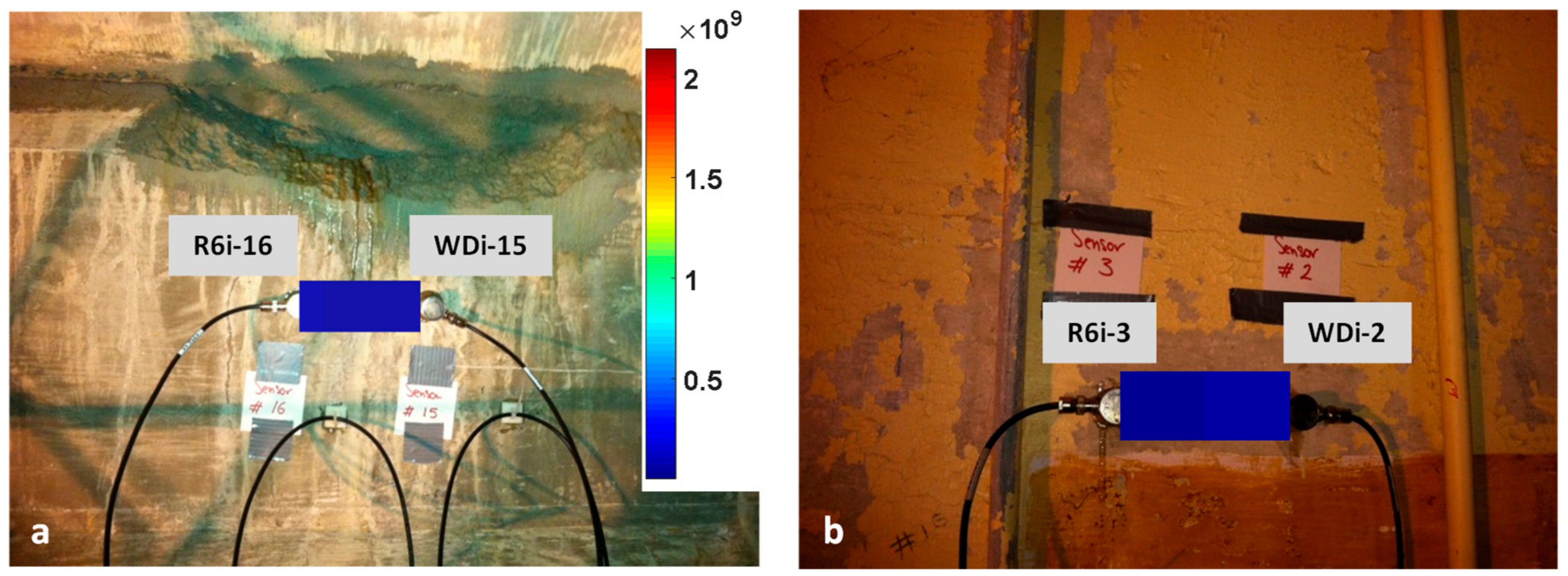
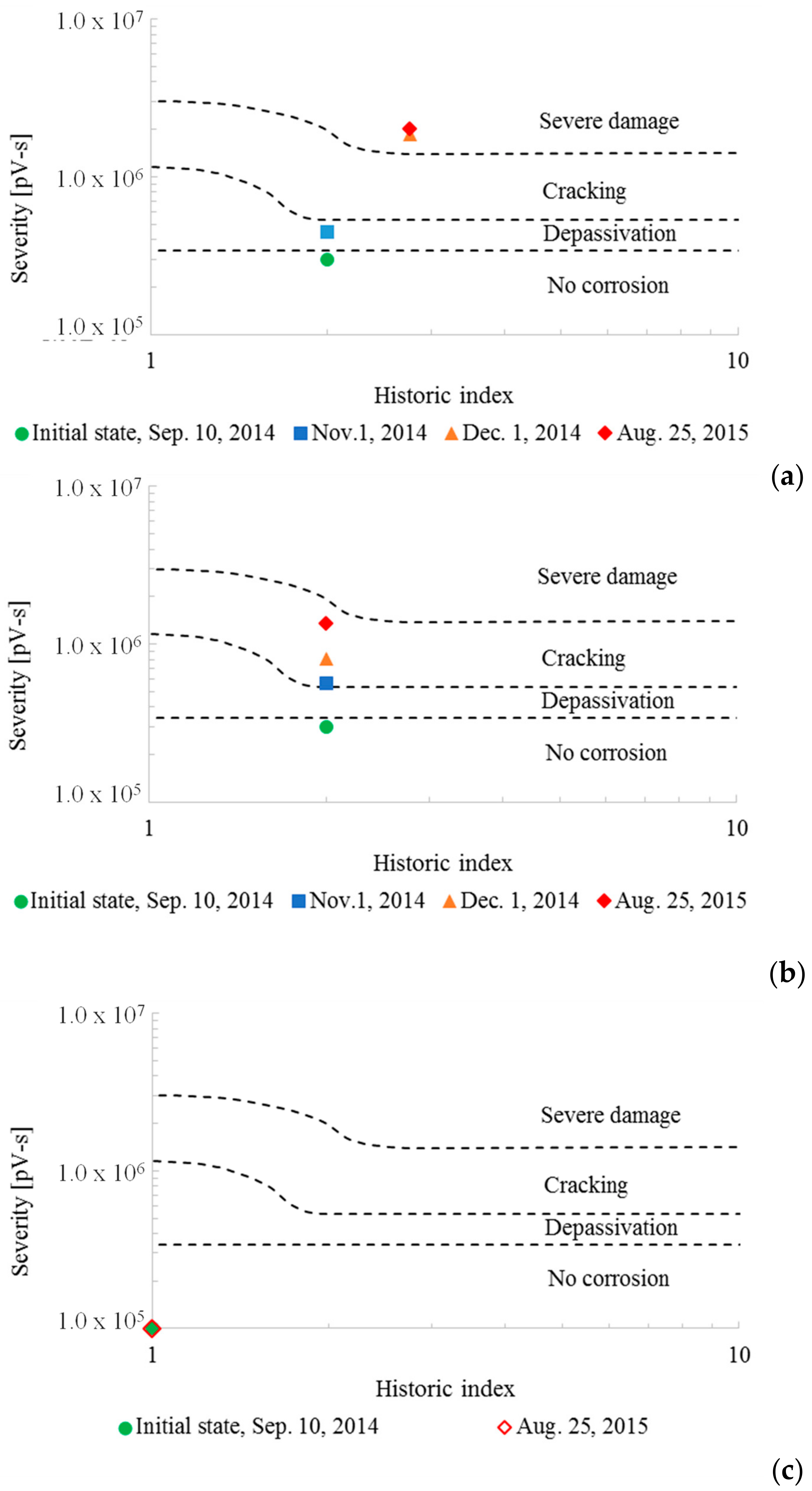
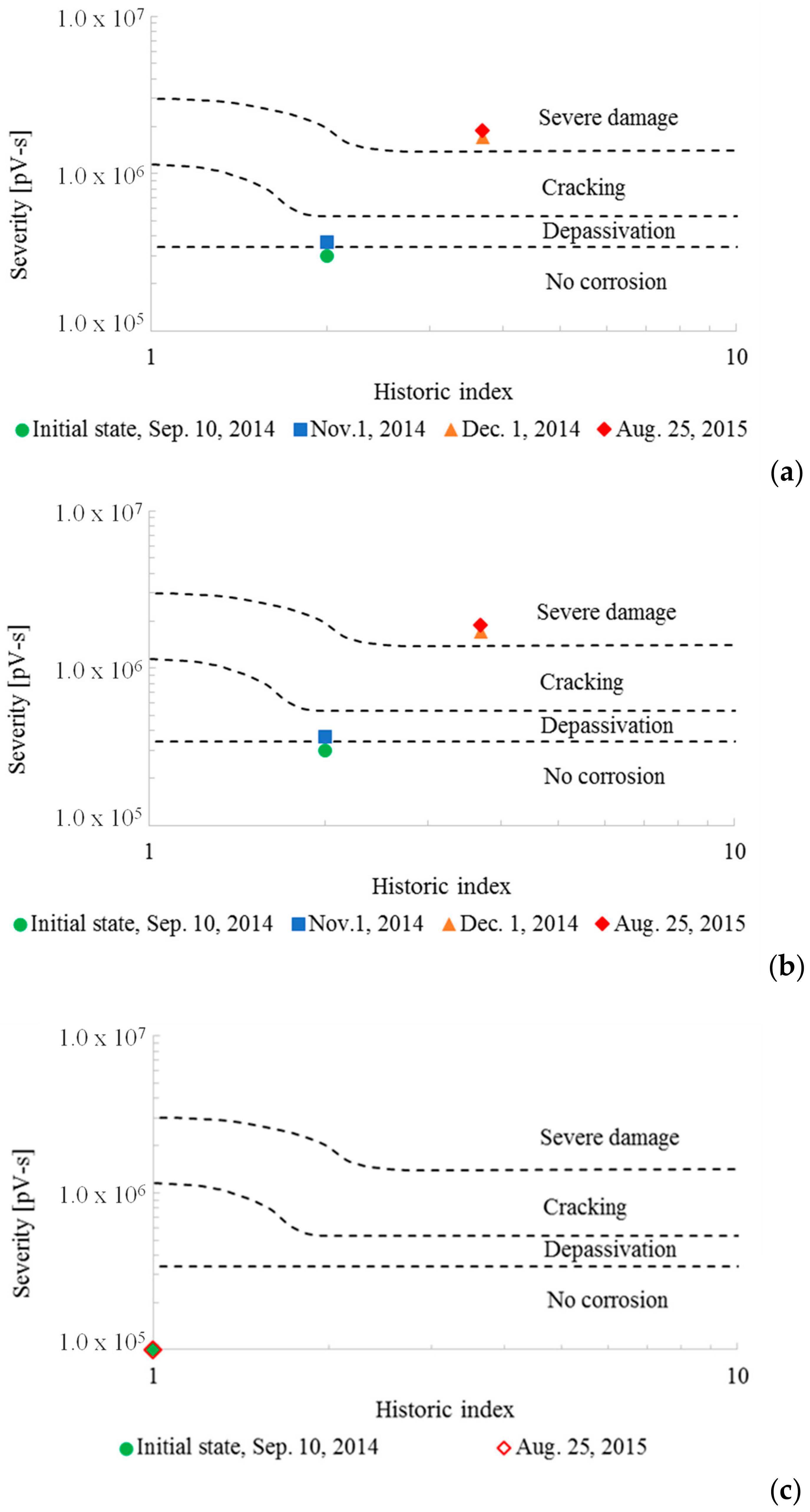

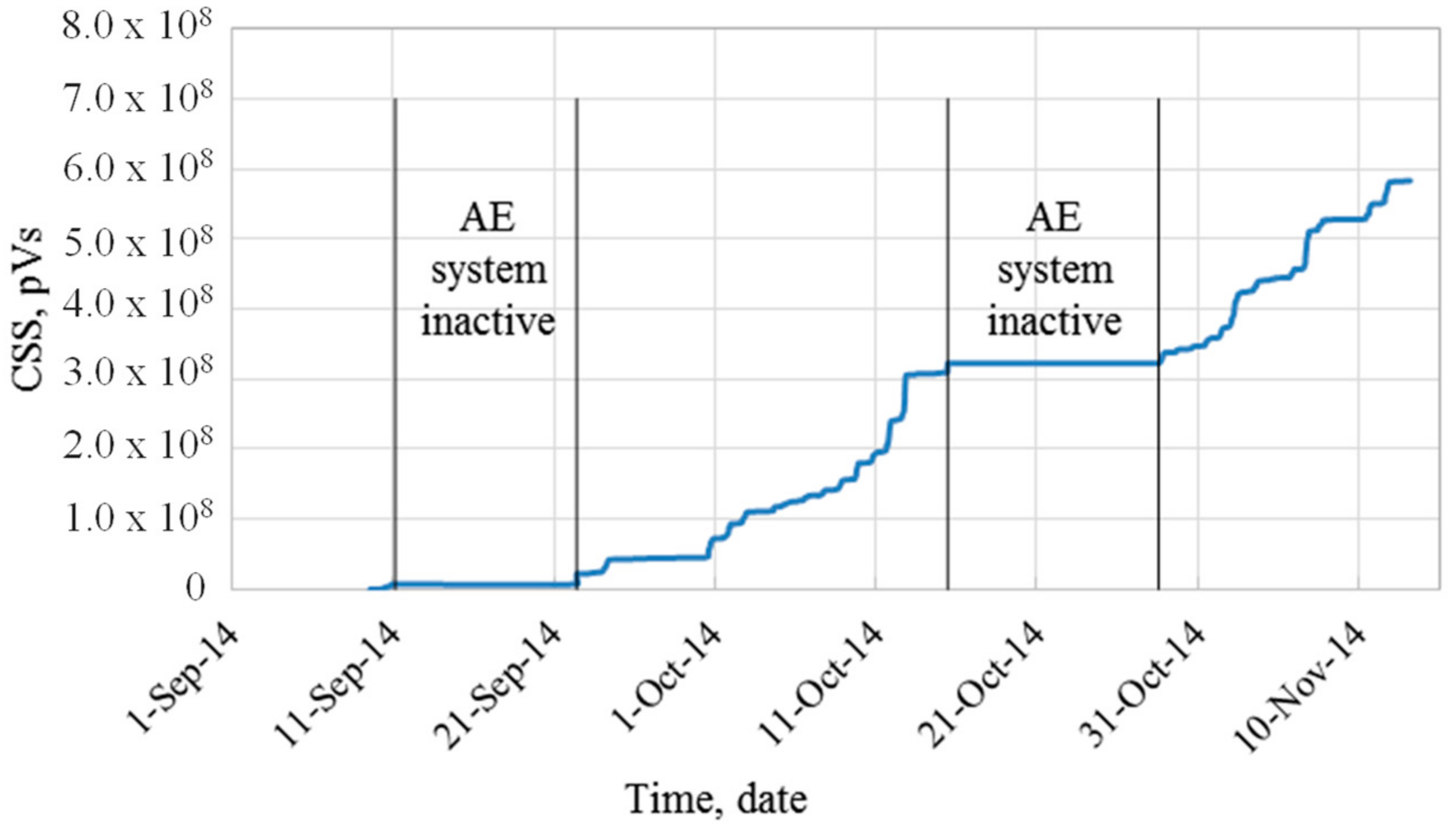
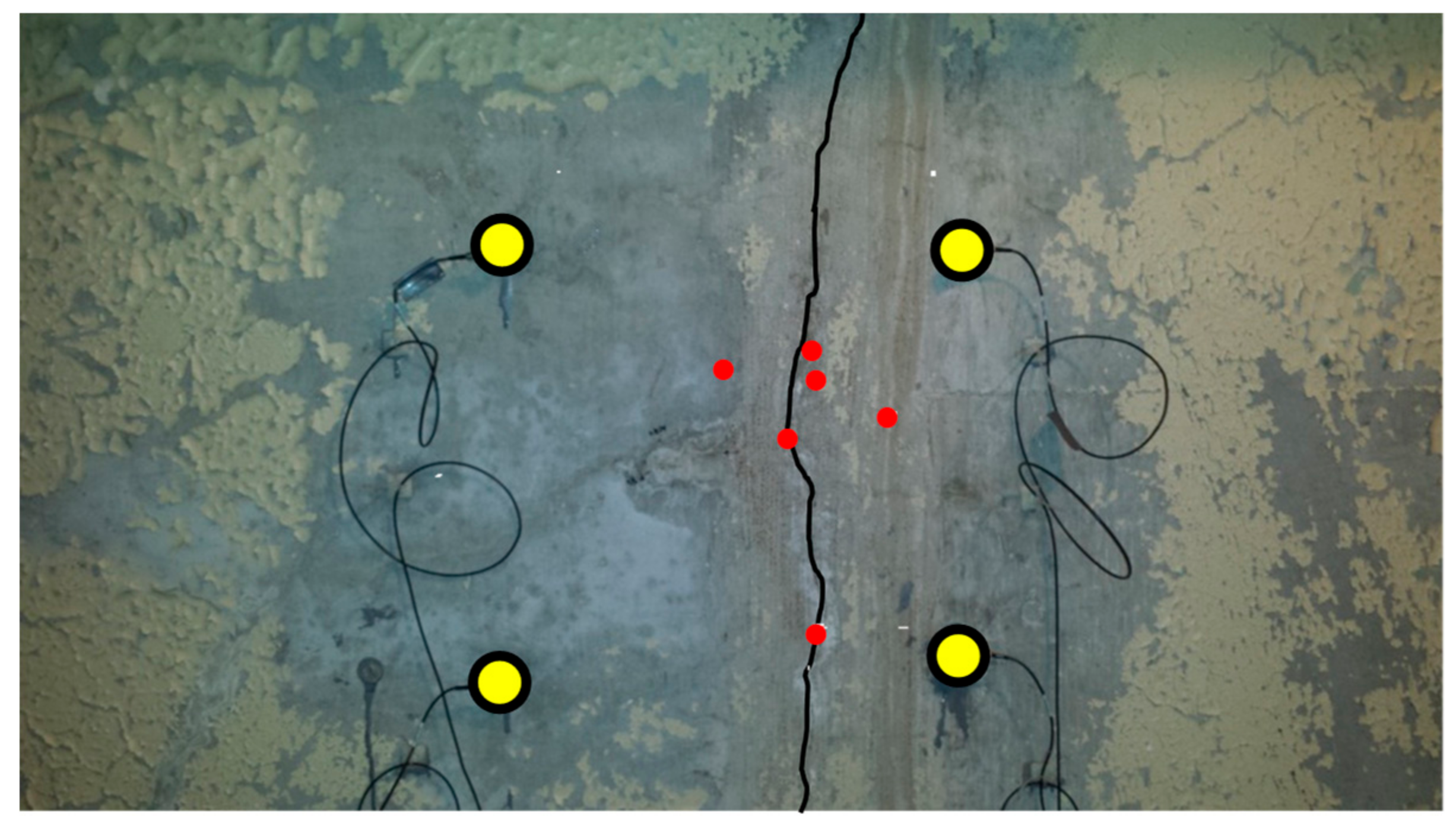
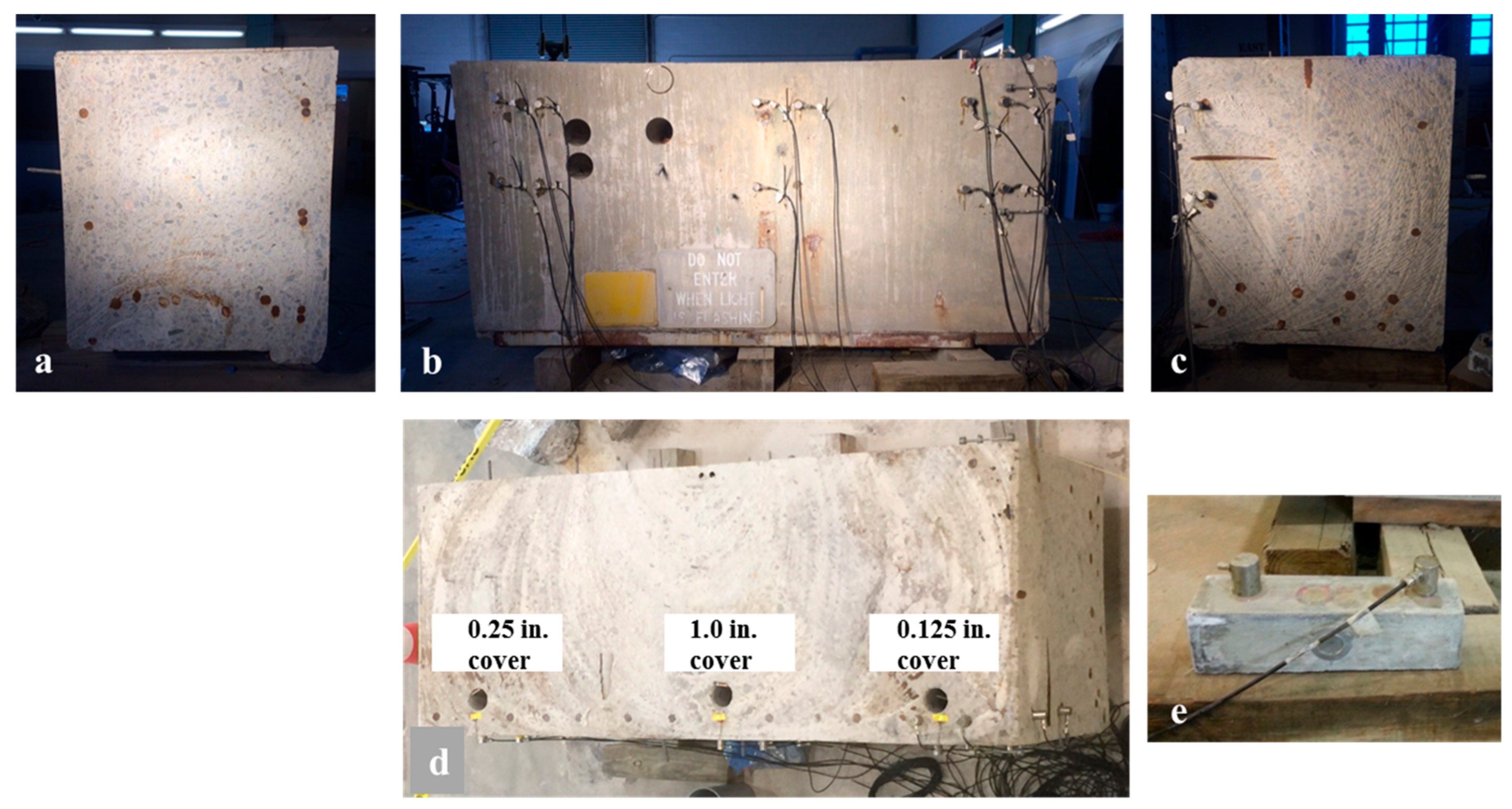
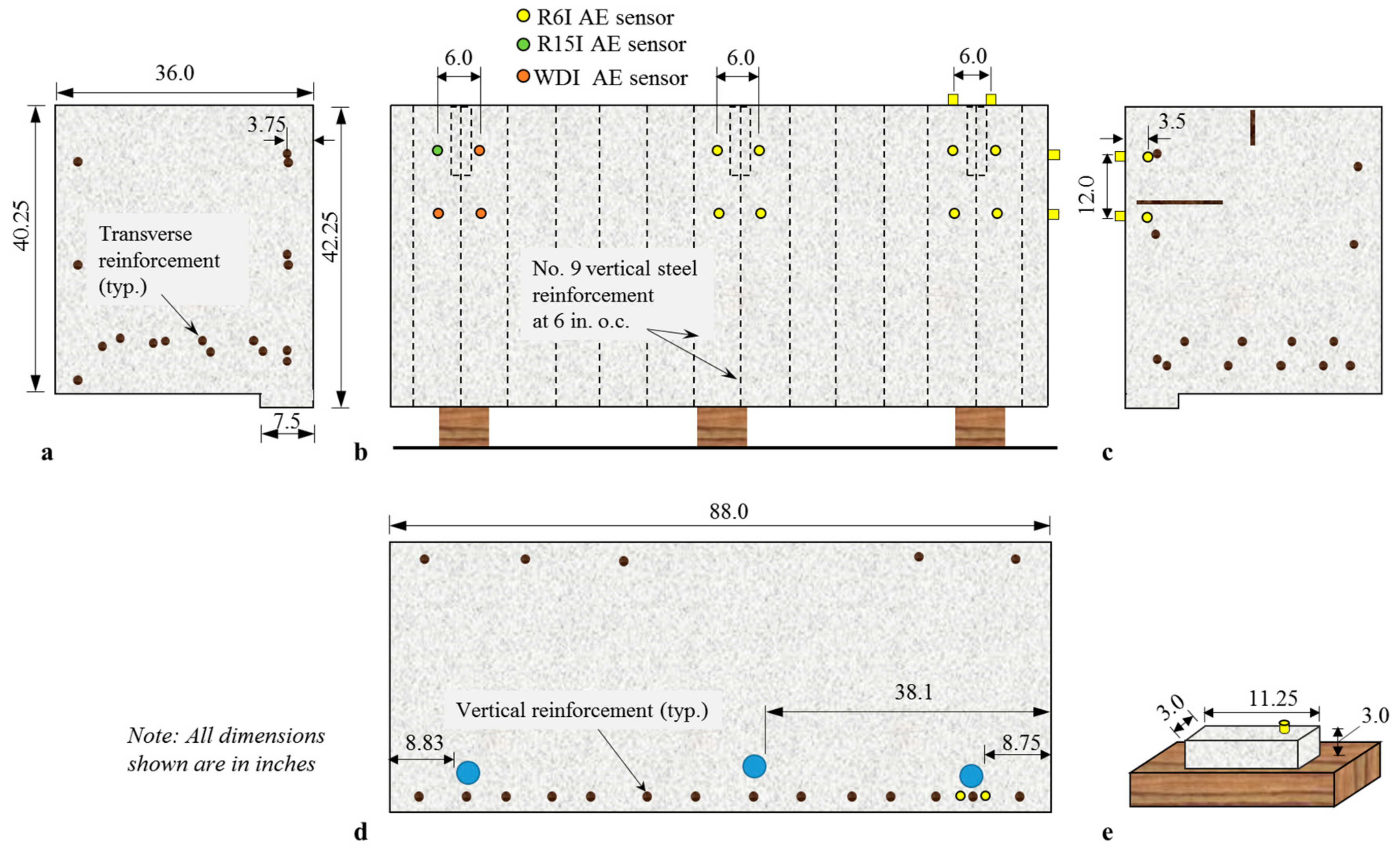
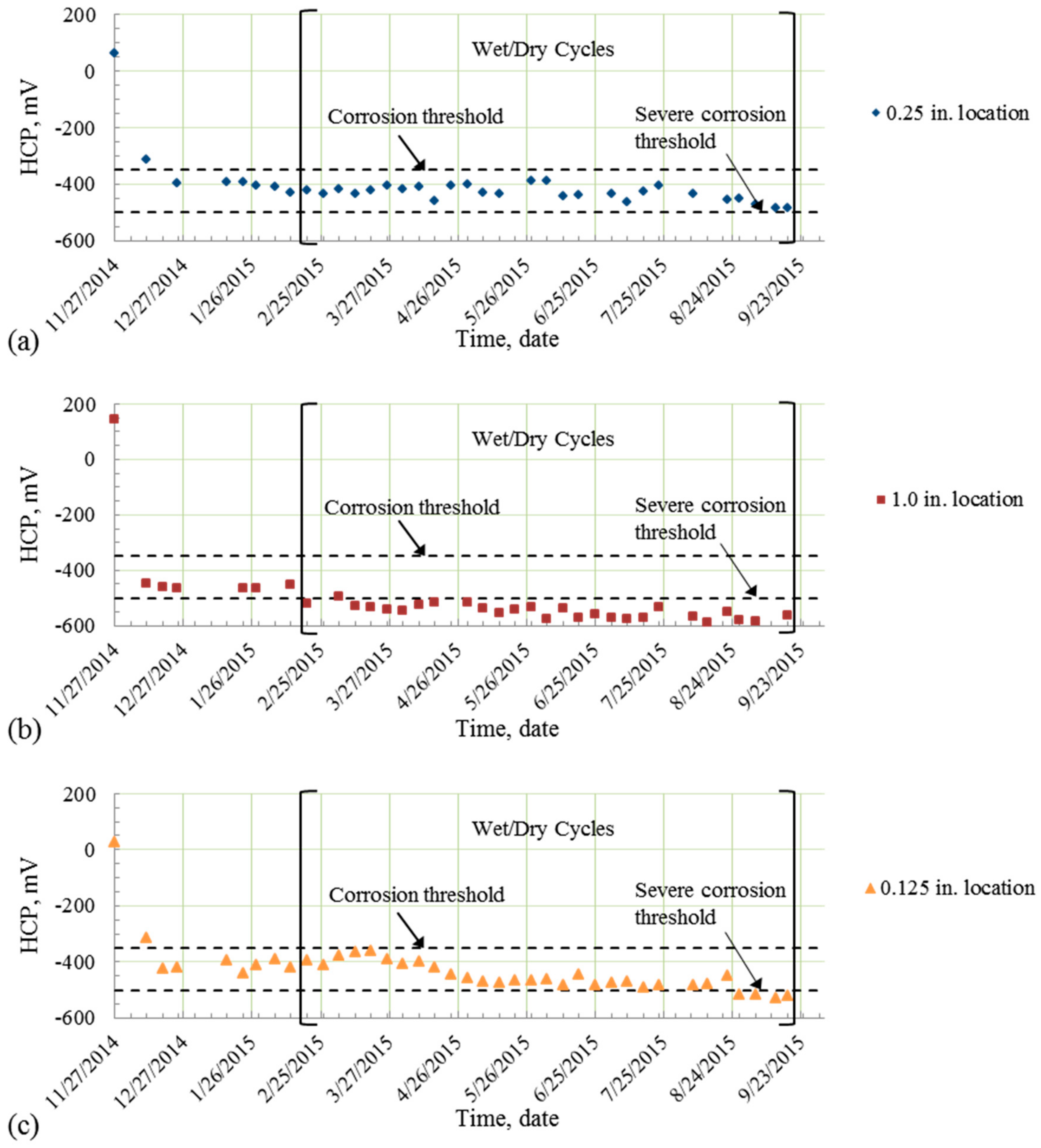
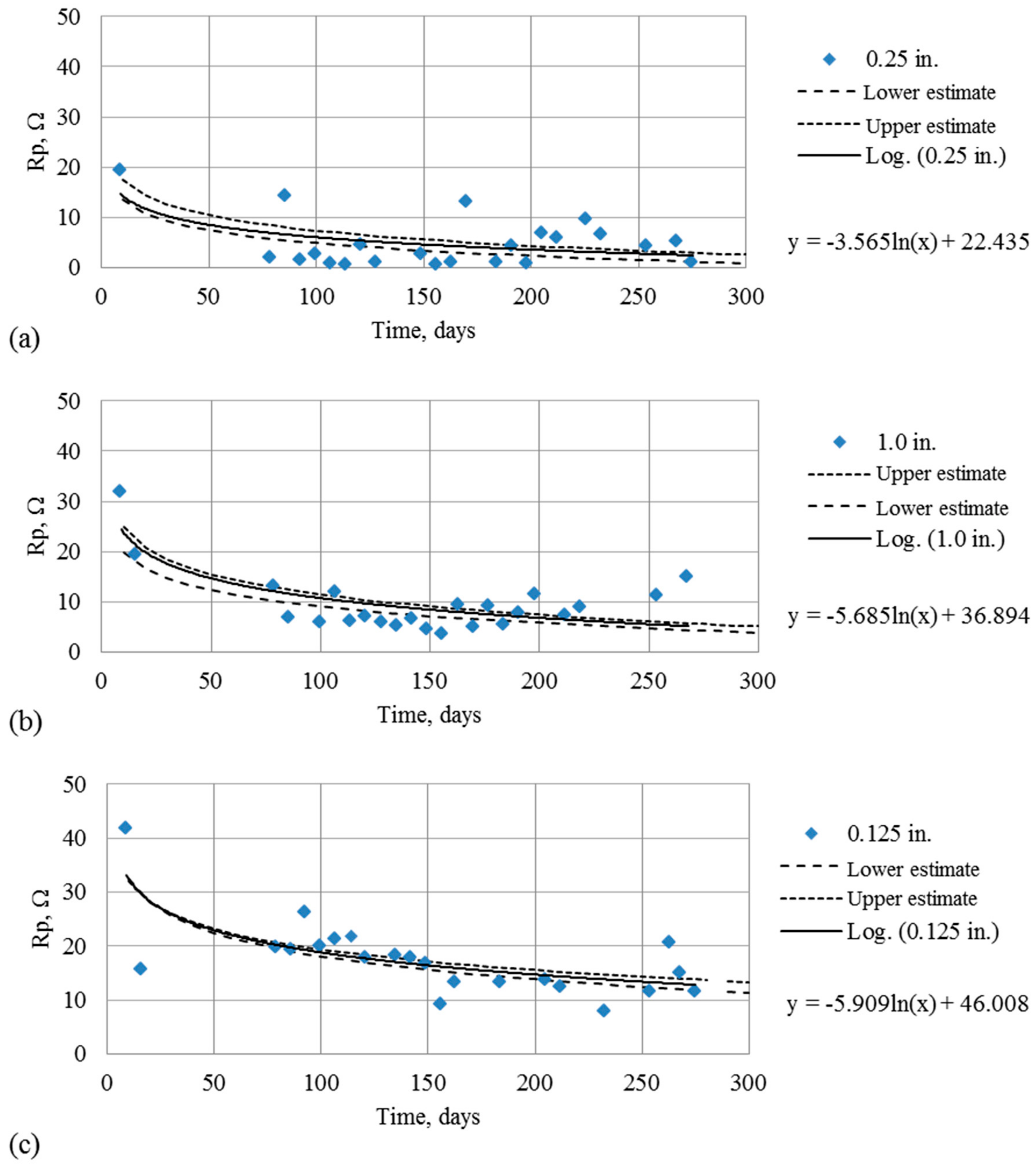
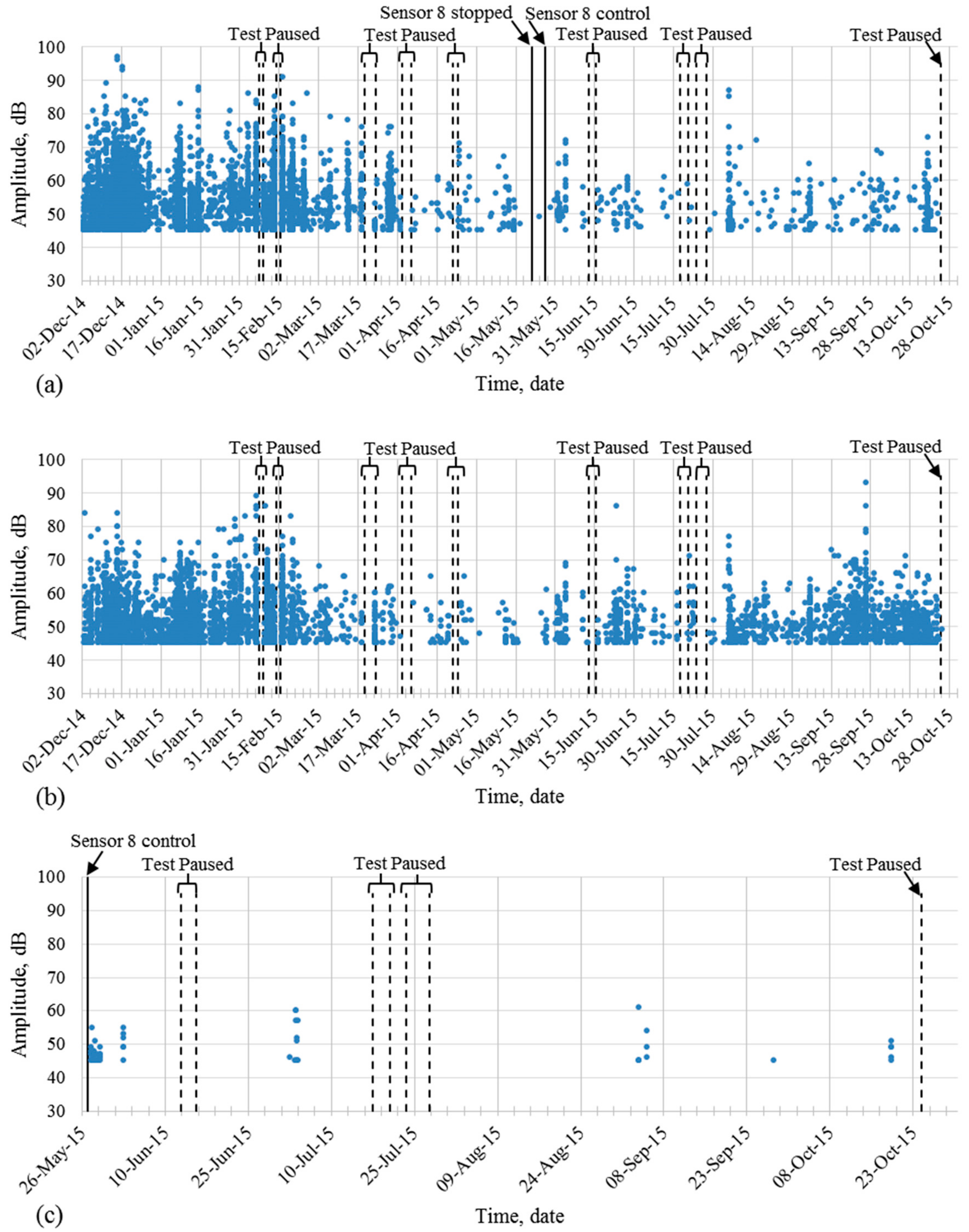
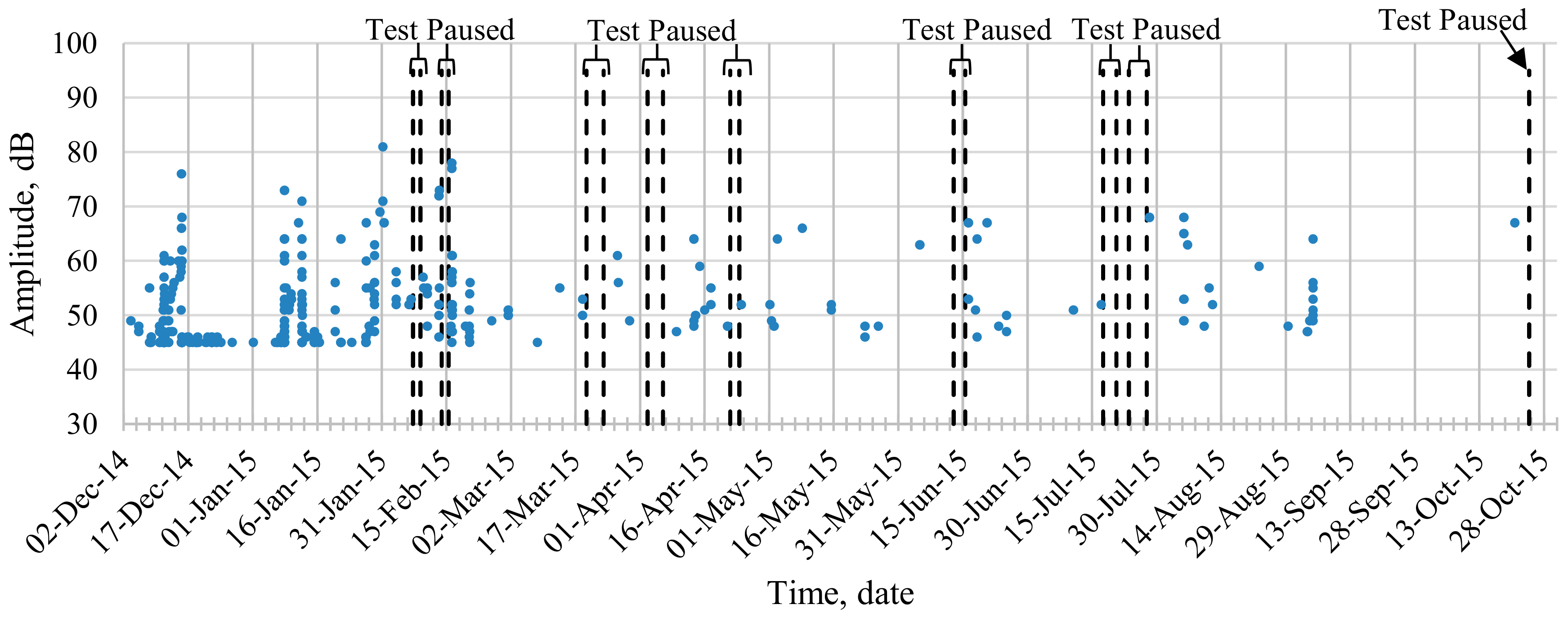

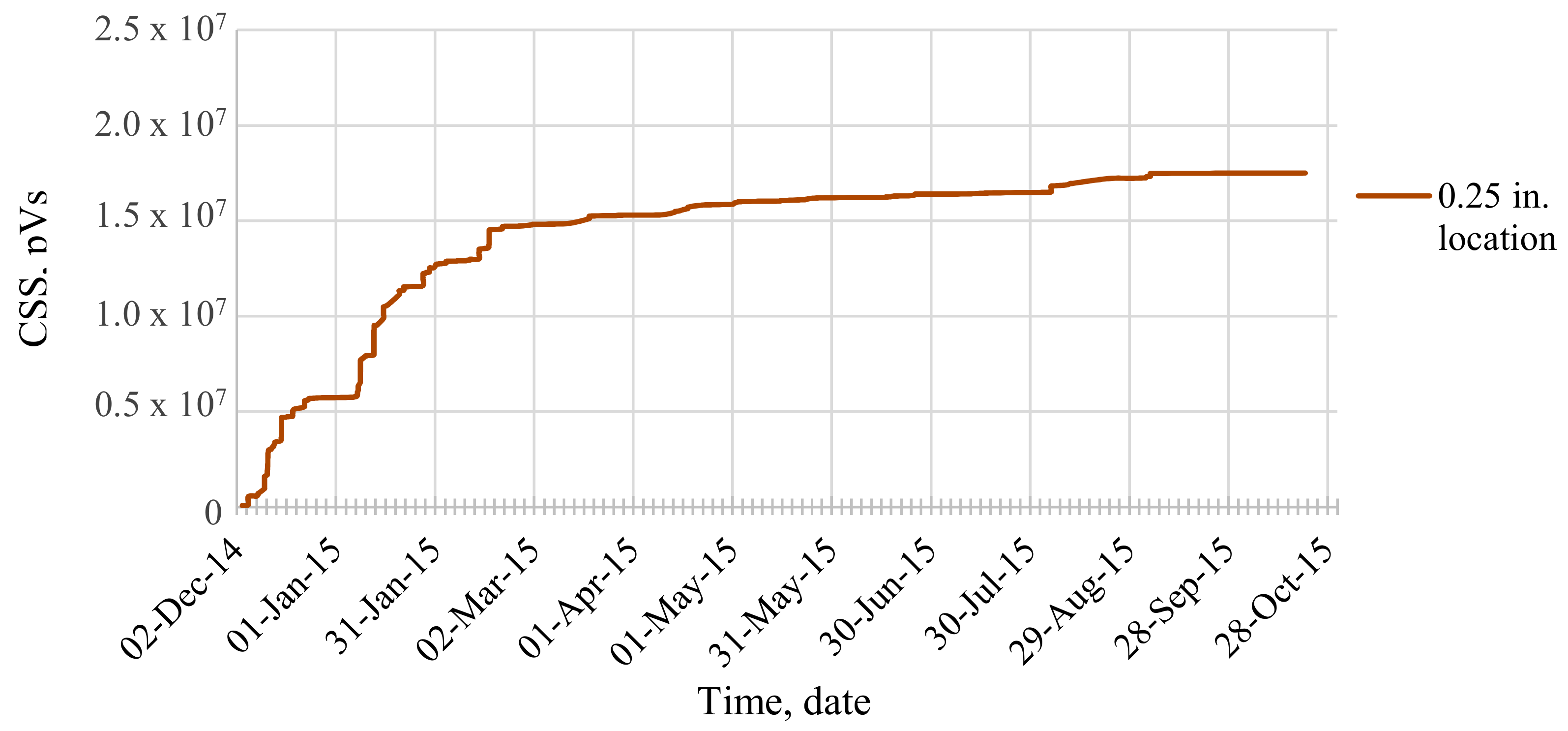
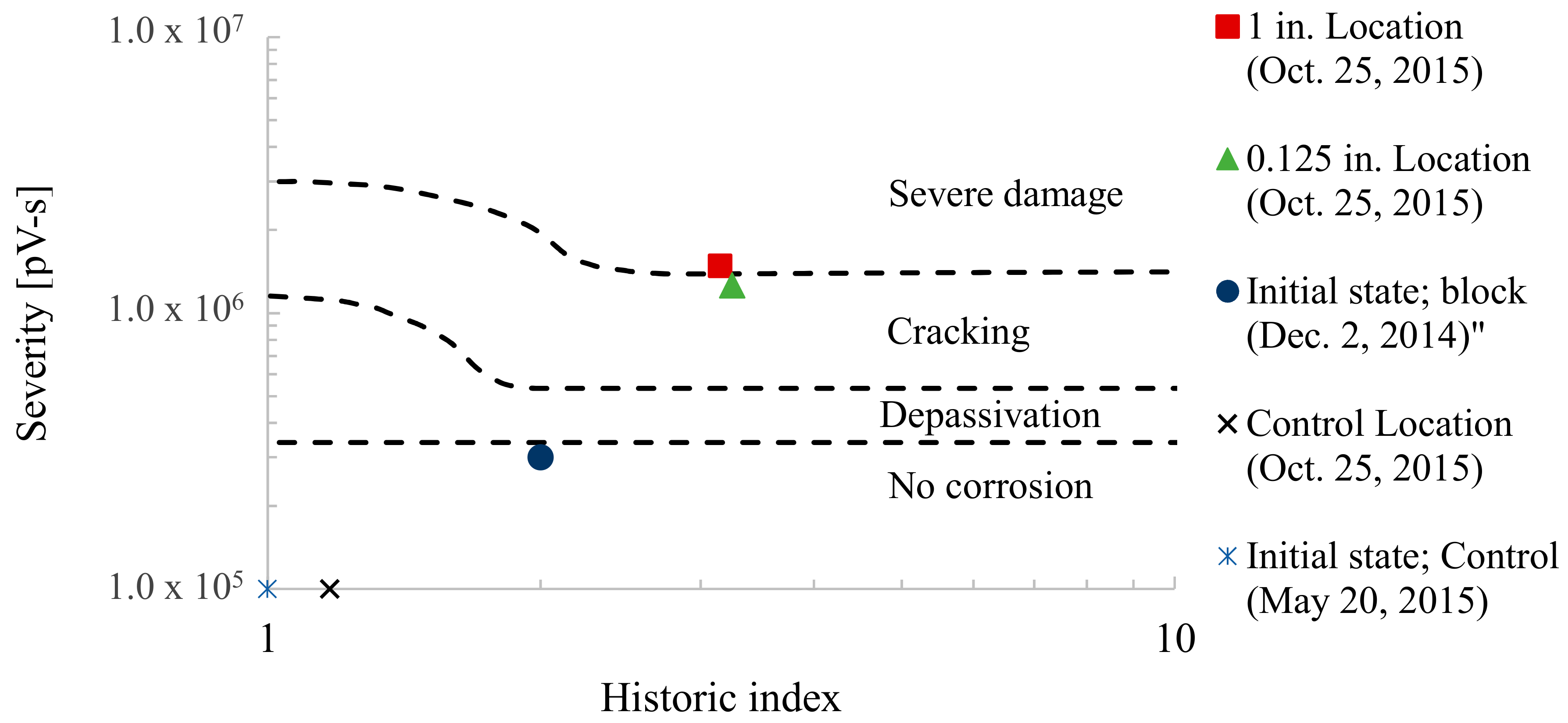

| Sensor Type-Channel | Horizontal Dimension (Inches) | Vertical Dimension (Inches) |
|---|---|---|
| WDI-9 | 0 | −10.5 * |
| R6I-10 | 8.5 | 16 |
| R6I-11 | 5.5 | 9 |
| WDI-12 | 11 | 5.5 |
| R6I-13 | 14.5 | 16 |
| WDI-14 | 15.5 | 8.5 |
| D-A Filter | R-A Filter | Duration (μs) | RMS Filter (V) | ||
|---|---|---|---|---|---|
| Amplitude (dB) | Duration (µs) | Amplitude (dB) | Rise Time (μs) | ||
| 45–50 | >500 | 45–50 | >40 | ≤100 | 0.0019–0.0041 |
| 51–55 | >1000 | 51–65 | >100 | ----- | ----- |
| 56–65 | >2000 | 66–100 | >150 | ----- | ----- |
| 66–75 | >3000 | ----- | ----- | ----- | ----- |
| 76–100 | >4000 | ----- | ----- | ----- | ----- |
| Potential Against Cu-CuSO4 Electrode | Corrosion Condition |
|---|---|
| >−200 mV | Low risk (10% probability of corrosion) |
| −200 to −350 mV | Intermediate corrosion risk |
| <−350 mV | High corrosion risk (90% probability) |
| <−500 mV | Severe corrosion damage |
© 2018 by the authors. Licensee MDPI, Basel, Switzerland. This article is an open access article distributed under the terms and conditions of the Creative Commons Attribution (CC BY) license (http://creativecommons.org/licenses/by/4.0/).
Share and Cite
Abdelrahman, M.; ElBatanouny, M.; Dixon, K.; Serrato, M.; Ziehl, P. Remote Monitoring and Evaluation of Damage at a Decommissioned Nuclear Facility Using Acoustic Emission. Appl. Sci. 2018, 8, 1663. https://doi.org/10.3390/app8091663
Abdelrahman M, ElBatanouny M, Dixon K, Serrato M, Ziehl P. Remote Monitoring and Evaluation of Damage at a Decommissioned Nuclear Facility Using Acoustic Emission. Applied Sciences. 2018; 8(9):1663. https://doi.org/10.3390/app8091663
Chicago/Turabian StyleAbdelrahman, Marwa, Mohamed ElBatanouny, Kenneth Dixon, Michael Serrato, and Paul Ziehl. 2018. "Remote Monitoring and Evaluation of Damage at a Decommissioned Nuclear Facility Using Acoustic Emission" Applied Sciences 8, no. 9: 1663. https://doi.org/10.3390/app8091663
APA StyleAbdelrahman, M., ElBatanouny, M., Dixon, K., Serrato, M., & Ziehl, P. (2018). Remote Monitoring and Evaluation of Damage at a Decommissioned Nuclear Facility Using Acoustic Emission. Applied Sciences, 8(9), 1663. https://doi.org/10.3390/app8091663






